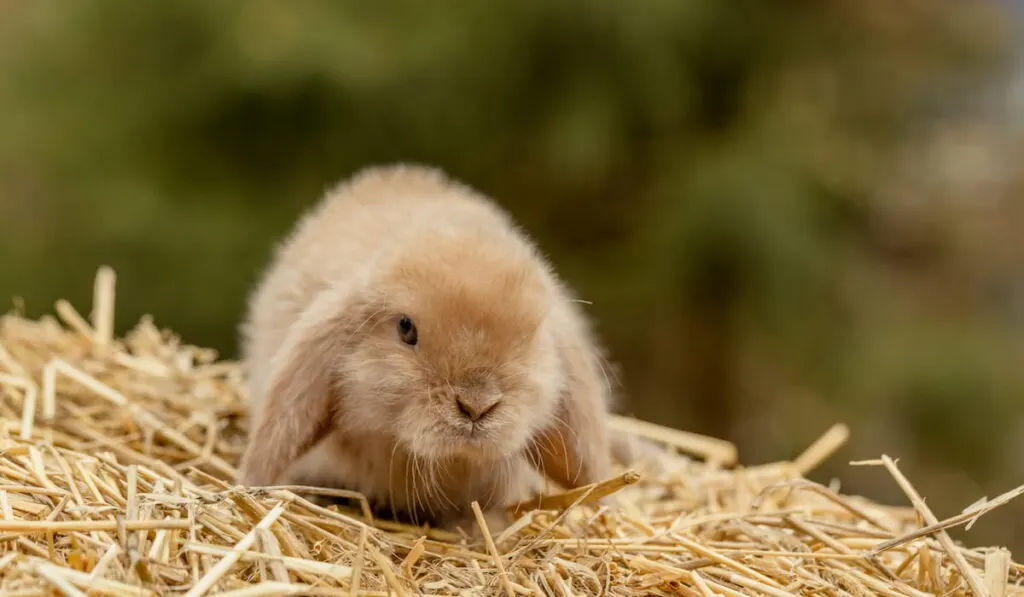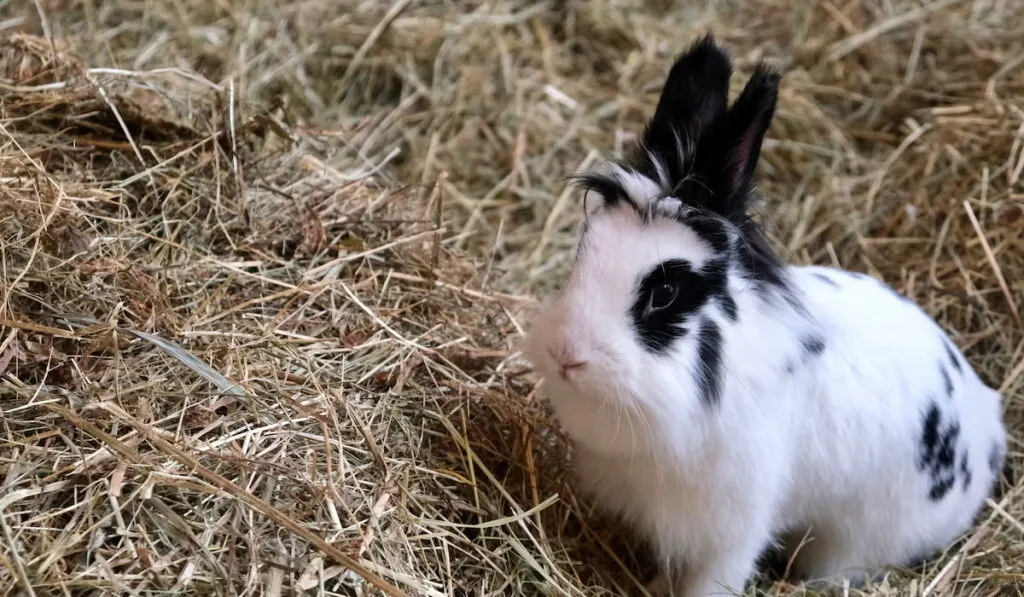Rabbits are herbivores who need high fiber feeds, specifically hay, to be healthy and active. Hay has the proper nutritional needs for a rabbit, and on its own, it is sufficient for a rabbit’s dietary needs. It helps keep the digestive tract healthy and prevents complications such as potentially lethal gastrointestinal stasis (GI) and obesity.
Rabbits love hay, and if your rabbit refuses to eat it, this could be a clear sign that there is a problem.
However, before we get to improve the hay uptake by the rabbit, what could be the possible causes of the denial to eat Hay?

Why Your Rabbit Doesn’t Eat hay
A rabbit’s refusal to eat hay is a clear indication of an underlying problem, either from the rabbit’s end or you, the owner, could be partly causing the inconvenience.
Below is a brief insight into the possible reasons that your bunny might not be eating its hay.
- Habits – It is recommended that a rabbit’s diet should be made of at least 80% hay. However, they may resist eating it if they are rarely exposed to it, especially if it is used to sweet treats like fruits, pellets, and vegetables.
A change in the feeding patterns might also imply a dental problem, and for this, an examination by your vet is necessary.
- The cage setup – rabbits often poop while eating, so raising the hay rack a little over the litter box will encourage them to eat more hay while defecating. This also reduces the chances of hay coming in contact with poop, ensuring that the rabbit eats clean food.
You should also ensure that you give your rabbit fresh hay that is not moldy, damp, or dusty and ensure that it has access to clean water. - Routine – You might be partly responsible for the problem if your rabbit fails to eat hay. A rabbit’s diet should consist of at least 80% hay, and you should not give it any less than that. Pellets, vegetables, and fruits should only be given as supplements and treats and not as part of their main diet.
For this, you should have a well-articulated feeding routine with a rabbit’s balanced diet to avoid overfeeding your rabbit with unnecessary feeds.
Why Your Rabbit Needs to Eat Hay
Rabbits are solely herbivores, meaning that they rely on plant materials for food. Hay should make up more than 80% of their diet. However, they may develop poor feeding habits, and it is our responsibility as guardians to help them improve from these bad habits and get them to love nibbling on hay.
Hay is specifically good for the following reasons.
- The high fiber content in hay is good for keeping the rabbit’s digestive tract healthy, preventing stool blockages and gastrointestinal stasis.
- A rabbit has 28 teeth, all of which grow to about 12 cm annually. These need trimming, but instead of visiting a vet for this, the rabbit can easily do it on its own if it nibbles enough hay.
The side-to-side chewing employed when chewing fiber is the most natural way to promote the essential wear to keep their enamels at an optimal length.
If your rabbit has excellent feeding habits with engaging and straightforward access to hay, it may consume a hay pile close to its body weight daily.
8 Tips for Getting Your Rabbit to Eat Hay
Now that we know the possible reasons for making the rabbit not eat hay and why hay is necessary for them, how do you get your rabbit to eat hay if it doesn’t, or improve its hay uptake if it eats too little?
Below are a few strategies to help you out.
1. Make Sure to Give Your Rabbit Fresh Hay

Compared to humans, rabbits have a superior sense of smell, and many times, they won’t eat hay that doesn’t smell fresh and delicious. To maintain the hay’s freshness, start by storing the hay in a cool and dry place, most preferably an airtight container or one with a proper seal.
You can also help by giving them hay that is just a little more than the required amount. This will ensure that they have hay just enough to sustain them for the day without much waste and avoiding stale hay.
It will help if you dump waste hay daily or re-use the leftover hay for the litter box to prevent too much waste.
2. Have a Feeding Plan for Your Rabbit
There should be extended periods between feeding times to make your rabbit force itself to eat hay to develop good eating habits. If possible, find a way to make hay available to your rabbit 24 hours a day and make pellets, vegetables, and other rare treats maybe once a day.
You should also have a schedule to feed your rabbit pellets and treats like fruits to avoid making them too available for the bunny since it will always go for the treats and leave the hay behind.
3. Create a Tasty Mix of Hay
When buying hay for your rabbit, avoid the finely chopped brownish hay packed in plastic bags available in most stores, but instead, go for hay with long green strands with a fantastic fragrance and not too much dust. You can also try out different types of hay to create a variety that will keep your bunny interested.
You can toss in some dry herbs to add fragrance and texture to the hay, making your rabbit more interested. Additionally, you can break open a raisin, a banana, or an apple and smear it on the hay to make it sweet enough for the rabbit.
Start by hand-feeding it with the laced hay and gradually reducing the fruit lacing once it is used to eating hay. This technique needs patience, but it works.
4. Make Feeding Fun for Your Rabbit

Rabbits are fond of playing and throwing toys around. Incorporating hay into the rabbit’s play activities increases the chances of pulling and nibbling on the hay, making it an effective strategy to increase hay uptake.
You could use rabbit toys like a willow ball or a cardboard tube to hold hay and maybe something interesting, like a raisin in the middle, and they may throw them around and end up eating some hay.
You could alternatively use hay racks with little enticement within the hay to feed them. These will always keep the hay high and dry, limiting hay mess and encouraging the rabbits to reach up for the hay.
5. Diversify Your Rabbit’s Hay
There exists a wide variety of hay with different tastes and textures, and some rabbits may prefer some brands to others.
To find the best combination of hay for your rabbit, you might have to try out a few more brands, different from what you have been feeding the rabbit, and you might eventually get your bunny to eat some hay.
Timothy and Meadow’s hay are the most popular, but you can also try grass hay, oat hay, orchard hay, hay blend, and botanical hay.
However, you should avoid alfalfa hay because it is too rich in calcium and proteins and is only essential for young bunnies or those that need to gain weight.
6. Feed Them Less Dry Food
Rabbits prefer eating dry feeds, and if they get used to eating many dry feeds besides hay, they may develop poor hay-eating habits. Dry feeds may taste delicious to the bunny but lack the essential fiber and chewing activity to keep the rabbit healthy.
Reducing the amount of dry feeds you give your rabbit should encourage it to nibble on the available hay.
7. Limit the Rabbit’s Favorite Feeds

Instead of eating hay, rabbits sometimes develop a bad habit of picking out the vegetables and pellets and leaving the hay for you to collect.
In this case, you should limit these foods to maybe giving them once or twice a week while making hay available on a full-time basis. They will gradually force themselves back on track with hay.
8. Mix Hay with Your Rabbit’s Favorite Feed
Try blending them with hay in the hay feeder instead of feeding hay separately from the pellets, vegetables, and other treats.
This may be slow in delivering positive results, but at the very least, the rabbit will nibble on a few strands of hay while digging in for what it prefers, and at the end, it will learn to eat hay.
Conclusion
Hay is crucially essential for your rabbit’s health, but if left to choose on their own, rabbits will always choose what is sweet and convenient to them over what is healthy for them.
As a rabbit owner, you should make better feeding habits for your pet to help maintain it in its most healthy shape.
When trying out these methods, use any combination you can think of. It might take a while, but it will be worth it in the end. After all, the ultimate goal is to get your rabbit to eat more hay so that he can be healthier.
Resources
- https://www.rabbitholehay.com/blogs/rabbit-hole-hay-blog/why-your-rabbit-doesnt-eat-hay-you-may-be-the-problem
- https://janabrock.com/happy-rabbit-tip-8-ways-get-rabbit-eat-hay/
- https://best4bunny.com/clever-ways-encourage-rabbit-eat-hay-matter-stubborn/
- http://www.therabbithouse.com/blog/2007/06/20/5-ways-to-get-your-to-rabbit-eat-more-hay/
- https://rabbitpros.com/rabbit-wont-eat-hay/
- https://www.hobbyfarms.com/5-tips-for-feeding-rabbits/
- https://www.rabbitholehay.com/blogs/rabbit-hole-hay-blog/tips-for-transitioning-to-the-best-hay-for-rabbits-based-on-their-age
